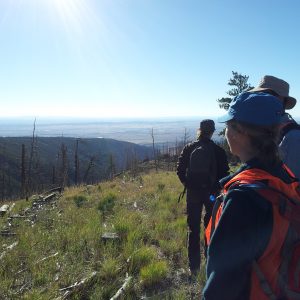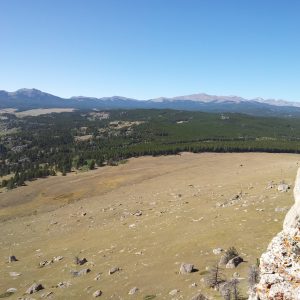What “X” Thinks I do
I think it is very interesting what people think I do as an CLM Intern. These are usually the responses I get.

Side Projects: JUNO System and Plant Identification
I am very happy to announce that I have completed two major projects. The first project was supposed to be GIS oriented. I developed shapefiles and geodatabases for many BLM employees. Previously, the BLM staff were given these Trimble JUNO systems, unfortunately they were not loaded with any important shapefiles. Many were not being used and were put aside. They did not have any important shapefiles installed and each of the systems were not really user friendly. I got to work by creating a series of shapefiles many workers could use. I went around and interviewed all of the range cons and scientists about their experiences with the Trimble JUNO System. I got crucial feedback that allowed me to tailor each of the devices to each of the employee’s needs. I created a powerpoint presentation to help make each of the JUNO systems user friendly. Hopefully, this would help many employees use the systems and be able to manage and create data more efficiently when out in the field.

A picture of myself using a photoshopped JUNO System. Seriously, I never really take pictures of myself in the office working on GIS…I would only attract stares… <_<
Another project I took upon myself was the plant identification project. Dan and I had some difficulty learning many of the plants when we were out in the field towards the beginning of our ES&R monitoring. Eventually, we learned a majority of them with the help of three textbooks. Anyways, I developed a large powerpoint for future interns, showing them the woody plants, grasses, and forbs they would most likely encounter out in the field. I provided detailed pictures and very good explanations on how to identify each plant. This powerpoint was specifically designed to identify local floral. Hopefully, this would aid future interns with monitoring. With the inclusion of the powerpoint, I updated the plant list for the Burns District. There were a couple of plants that we encountered that were not on the list, so I added them.
I got the projects completed at the right time. Most of the month Burns, Oregon has had thunderstorms and monsoon rains moving through the area. Doing field work would be difficult due to the wet and muddy roads. Staying nice and cozy in the office was nice during the rainstorms, but I missed being in the field. Next week, it was supposed to be colder and not as wet. Good conditions for field monitoring!
The Adventures of Monitoring Mule Deer
My next major project for the BLM was to do Mule Deer monitoring. Our goal was to go out into the field and do Pace 180 and belt transects to find pellet groups. Like a presence and absences study. I am working with three other employees that had worked in the Five Creeks area. We were using a random sampling method for each of the sites we were monitoring. There were four types of sites ranked on hydrology and tree canopy cover. (I am giving you the basics, if I were to tell you the full methodology, it would be at least 5 pages long… :p)
There was a large amount of rain lately in the area and the temperatures were dropping to below freezing. The monsoonal rains from the south created very muddy road conditions. The terrain was very hilly and covered with snow since we were on the foothills of the Steen Mountains. Thomas, Lisa, an Australian dude named Fletch, and I went into the field with an OHV to test the methodology. This guy from Australia was a volunteer from the BLM stables who wanted to see wild Kiger mustangs. Lisa brought him along, because we were going to be in an area full of Kiger mustangs. The surrounding landscape was breath taking! This area had been constantly managed and provided good habitat for a variety of creatures, especially mustangs, elk, deer, and pronghorn. The ground was covered with snow, but we were able to identify the plant species in our transect. We found a large amount of pellet groups along the transects, so we had many belt transects to complete.

The landscape we worked in… there was snow present on the ground…even if the picture does not show it.
We dropped Fletch off near a mustang herd and he was viewing them from a distance. We were located nearby monitoring a random point that was located near a mesic zone. Even with the snow and freezing temperatures, we managed to find some flowers that were still blooming! Thomas was a wildlife biologist and was showing me how to tell the difference between the different scats that we were monitoring. He was very happy to see a variety of different ungulate scat scattered throughout the landscape.

Kiger Mustangs!!!!!
The day was very successful, even with the muddy roads. Fletch was very excited to see a large number of mustangs. We ate our lunch and viewed many of the mustangs with our binoculars. They were all aware of our presences, but they all seemed very laid back. Lisa was giving a lecture about this specific herd and could identify individual horses based on their markings and behavior. We went home exhausted from all of the traveling and monitoring but we were all very happy.

This is what the tire looked like after we came back from the field. Looks like rocky road ice cream. ^_^
We were supposed to do this for another week, but everything was put on hold due to a meeting we were supposed to attend back at the office on Monday…
BLM Legends, ASSEMBLE!
I usually arrive at the BLM office between 5:30 am to 5:45am. The usual staff was talking about future projects, but there was a different mood in the air. Recently, there was talk of a government shutdown. Many of the employees were nervous about having to put work on hold due to the shutdown. Some employees were very optimistic and believed there would not be a government shutdown at all. I have been getting emails from Krissa and Wes updating us on our actions we were supposed to take in case the government did shut down.
The meeting started at 9:00am and every employee attended. The mood was very somber, but I was beyond excited to see all of the BLM staff of Burns, Oregon in one room. It was like all of the Legends came under one roof to discuss about something important. (It was horrible what everyone was going through. Everyone cared about their job and the people they worked with. I felt bad, but optimistic that everything would be alright.) I saw my boss and discussed with him about future projects I was thinking of doing. When the meeting started the higher bosses clearly gave us a rundown on what to expect. I thought to myself, “Ha! There is no way the government will shutdown.”
Life during the Government Shutdown and What I learned
The next day the government shutdown. I quickly visited my boss before to discuss what I should be doing during the government shutdown.
Myself: Hey! I could volunteer and help out anyway I can. Do you want me to do anything?
Casey: Nope, you can not do any work what so ever.
Myself: Can I work with the JUNO Systems…
Casey: Can’t work with any government property. If you are caught doing work, you could be in trouble. Best to take it easy and wait.
Myself: Can I…
Casey: Does it involve work?
Myself: ….yes……
Casey: This is my advice. This should blow over soon. Enjoy your break! Go bird watching, identify plants, or do something spontaneous that is not work related.
Myself:….okay…are you sure…
Casey: Have a nice break!!!
Myself: Okay! ^_^
After this discussion I decided to improve my CLM intern skills outside of work. I took Casey’s advice and did something spontaneous. I went to San Francisco, California.
I went with another BLM employee (Chas). We camped near Medford, Oregon and Eureka, California. When we got to San Francisco, we stayed at a friend’s house and unpacked. The apartment had many other government employees and interns that came from many different government organizations to stay until the government shutdown blew over.

San Francisco !!
I had many chances to talk with different employees about their jobs and got very good insight. I learned what different organizations did for the government. I was surprised about all the different jobs that were out there. BLM, USGS, USFS, FWS, National Park, and other service employees were present discussing their views on their job. Getting together with people working from different services helped me grasp the importance we all play for our nation. I was very excited to learn about what each person had to say.
After meeting a variety of government employees on my trip, I decided to travel to the bluegrass festival in town and meet up with different friends that lived in the Bay Area. I went on many hikes and did a lot of bird watching and plant identification. I gave a couple of lectures to my friends about the local flora and birds of the San Francisco area. I gained a lot of skills on my trip to San Francisco. Even if I was not working, I was still learning and applying the skills I learned from my CLM internship to help other people out.
Misadventures
Redwood Forest
The Redwood Forests of the west coast could be found in Oregon and California. I spent most of my time within the California Redwoods on my time off of work a week before the shutdown. (To make up for the comp time.) I had been here with my family many times before. The massive trees just blew me away due to their sheer size and shape. Walking through the understory, I could see a variety of different salamanders, birds, and everyone’s favorite invertebrate the banana slug! There were many trails that went through the landscape. I felt like I was living during the time of the dinosaurs, because everything looked prehistoric!
The fog that envelopes the forest in the early morning provided a sense of beauty. The sunrise gave the forest understory a golden color that refracted with the fog. I could hear the Stellar Jays and the American Crows cawing and screeching overhead as different hawks were migrating through the area. The ground was very soft. The detritus and fallen vegetation provided excellent habitat for various fungi, slime molds, invertebrate, and ferns. The massive trees that have fallen created unique topography that altered the flowing streams. After working in the desert and sagebrush communities, the stresses of the environment could wear on you after a while. As I walked through the giant forests I felt at peace.

Super Strong! >:)

Redwood Forest!!!

Darlingtonia californica: California pitcher plant/ cobra lily
Season Finale: Next Post
The end of the internship is drawing to a close. Next post will be all of what I have learned and gained from my internship. Lost stories, Justin comics, and side adventures would be featured.
(/O_O)/…..To be continued…… \(O_O\)
Justin Chappelle
CLM Intern for the Burns, Oregon BLM

And now….have some cute sea lions…















